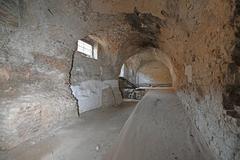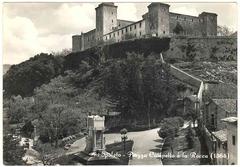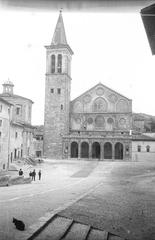Roman Theatre of Spoleto: Visiting Hours, Tickets, and Historical Sites Guide
Date: 14/06/2025
Introduction to the Roman Theatre of Spoleto
The Roman Theatre of Spoleto is a striking testament to ancient Roman architectural innovation and cultural vitality, situated in the historic heart of Spoleto, Umbria, Italy. Built in the 1st century BCE, this theatre encapsulates Spoleto’s strategic and social prominence during Roman times. Over centuries, it has evolved from a bustling venue for public performances and civic gatherings to a cherished archaeological site and vibrant stage for cultural events. Visitors are invited to explore its sophisticated design, including the semi-circular cavea, ornate stage building, and rare polychrome marble orchestra flooring, all of which highlight Roman engineering and artistry. The theatre’s partial integration with the city’s ancient urban landscape and its layered history—including medieval adaptations and 19th-century rediscovery—provide a unique bridge between antiquity and modernity.
Today, the Roman Theatre continues to serve as a cultural hub, especially during the renowned Festival dei Due Mondi, which enlivens the ancient space with world-class performances in opera, theatre, and dance. Practical information such as visiting hours, ticket options, multilingual guided tours, and accessibility services ensures an informative and welcoming experience. Its proximity to other significant landmarks—like the Rocca Albornoziana, Basilica of San Salvatore, and the National Archaeological Museum—makes the theatre a central stop for those eager to immerse themselves in Spoleto’s rich historical tapestry.
For current updates and comprehensive visitor resources, official tourism websites provide essential details, including virtual tours and interactive maps. Whether you’re an enthusiast of history, architecture, or culture, the Roman Theatre of Spoleto promises a captivating journey into Italy’s past and present (Umbria Tourism, Ancient Theatre Archive, Festival dei Due Mondi).
Table of Contents
- Introduction
- Origins and Historical Significance
- Architectural Features
- Site Layout and Orientation
- Construction Materials and Techniques
- Dimensions and Capacity
- Cavea: Seating Structure
- Orchestra and Stage Area
- Integration with the Urban Fabric
- Structural Challenges and Preservation
- Later Modifications and Adaptive Reuse
- Visiting Information
- Nearby Attractions
- Visuals and Interactive Elements
- Travel Tips
- Frequently Asked Questions (FAQ)
- Conclusion
- References
Origins and Historical Significance
Constructed in the 1st century BCE, the Roman Theatre of Spoleto underscores the city’s prominence as a Roman municipium. Built into the hillside within the ancient core, it accommodated up to 3,500 spectators, reflecting advanced Roman engineering. The theatre was central to civic life, hosting dramatic performances, public ceremonies, and political gatherings that reinforced Roman social and political structures (Ancient Theatre Archive).
Architectural Features
The theatre’s semi-circular cavea is divided into three tiers, with a richly decorated stage building (scaenae frons) and design innovations such as vomitoria (entrances/exits) and a retractable velarium (awning). Built with local limestone, bricks, and marble, it reflects the grandeur and technical prowess of Roman public architecture.
Site Layout and Orientation
Positioned just inside Spoleto’s ancient city walls, the theatre is set on an artificial terrace—a feature of Roman, rather than Greek, theatre construction. Its orientation, with entrances from Via Sant’Agata and views from Piazza della Libertà, demonstrates sophisticated urban planning and integration with Spoleto’s defensive structures (Umbria Tourism).
Construction Materials and Techniques
Attributed to Gaius Calvisius Sabinus, the theatre was constructed using opus caementicium (Roman concrete), local limestone, and bricks. Later renovations employed opus reticulatum, enhancing the structure’s durability. These materials contributed to the theatre’s longevity and resilience (Ancient World Magazine).
Dimensions and Capacity
The cavea spans approximately 72 meters in diameter, with the orchestra measuring 21.7 meters across. The seating arrangement accommodated between 2,800 and 3,500 spectators, making it a major venue for public gatherings (Ancient Theatre Archive).
Cavea: Seating Structure
Seating is organized into three sections:
- Ima Cavea: Closest to the orchestra, reserved for elite citizens (11 rows).
- Media Cavea: Middle section for male citizens.
- Summa Cavea: Uppermost tier for women and children (13 rows).
Beneath the cavea, a barrel-vaulted corridor allows for crowd movement and supports the structure (Live the World).
Orchestra and Stage Area
The orchestra preserves rare polychrome marble slabs from the Roman Empire, some dating to the 4th century CE, offering a glimpse into the luxurious decor of ancient theatres. Medieval adaptations, including the construction of the Church of Sant’Agata and the Corvi family palazzo, altered the original stage area (Ancient Theatre Archive).
Integration with the Urban Fabric
Part of the theatre’s eastern wall is incorporated into Spoleto’s ancient fortifications, illustrating the Romans’ ability to blend entertainment spaces with urban defenses (Ancient Theatre Archive).
Structural Challenges and Preservation
A geological fissure caused the western cavea to shift by 2–3 meters, but Roman repairs and subsequent restorations have preserved the site for modern visitors. The theatre remains one of the best-preserved Roman theatres in Umbria (Ancient Theatre Archive).
Later Modifications and Adaptive Reuse
After the Roman period, the theatre’s stones were reused for other buildings. The 12th-century Church of Sant’Agata and a Benedictine monastery (established 1395) were built atop its ruins. Rediscovery and excavation began in 1891, revealing the original Roman structure (Umbria Tourism).
Visiting the Roman Theatre of Spoleto
Visiting Hours and Tickets
- Hours: Open Tuesday to Sunday, 9:00 AM – 7:00 PM (last admission at 6:30 PM). Closed Mondays and major holidays. Hours may vary seasonally or during special events—confirm via the official website.
- Tickets: Standard adult ticket €8; reduced rates for EU citizens 18–25; free entry for children under 18. Tickets are available at the entrance or online (Umbria Tourism).
- Combo Tickets: Combined tickets with the National Archaeological Museum are available.
Accessibility
The site offers partial access for visitors with limited mobility. Some uneven surfaces and steps are present, but ramps and assistance are available upon request. For specific needs, contact the visitor center before your visit.
Guided Tours and Special Events
Guided tours run daily at 11:00 AM and 3:00 PM in multiple languages. Advance booking is recommended, especially during the Festival dei Due Mondi (June–July), which features international opera, theatre, dance, and music performances (Festival dei Due Mondi).
Nearby Attractions
- Rocca Albornoziana: Medieval fortress overlooking Spoleto.
- Arch of Drusus and Germanicus: Roman triumphal arch.
- Basilica of San Salvatore: UNESCO-listed early Christian church.
- National Archaeological Museum: Adjacent to the theatre, with artifacts from Spoleto and the region.
Visuals and Interactive Elements
High-quality photos and virtual tours of the theatre are available on the official tourism portal, with descriptive alt tags for accessibility. Interactive maps help visitors plan their route through Spoleto’s historical sites (Umbria Tourism).
Travel Tips
- Best Time to Visit: Early mornings or late afternoons to avoid crowds.
- Combine Visits: Explore the theatre alongside Spoleto Cathedral and Piazza della Libertà.
- Comfort: Wear comfortable shoes for uneven terrain; bring a camera for architectural highlights.
- Amenities: The historic center offers various cafes and restaurants; Ristorante Apollinare and Il Tempio del Gusto are recommended nearby (Strictly Italy).
Frequently Asked Questions (FAQ)
Q: What are the Roman Theatre of Spoleto’s opening hours?
A: Tuesday to Sunday, 9:00 AM–7:00 PM, closed Mondays.
Q: How do I purchase tickets?
A: Tickets are available at the entrance or online through the official tourism website.
Q: Are guided tours available?
A: Yes, daily at 11:00 AM and 3:00 PM; advance booking is advised.
Q: Is the theatre accessible for people with disabilities?
A: Partial accessibility with ramps and staff assistance; inquire in advance for specific requirements.
Q: When is the Festival dei Due Mondi?
A: Annually in June and July, with a full schedule available on the festival’s official site.
Historical Context and Evolution
The theatre’s origins date to the late 1st century BCE, reflecting Spoleto’s status as a Roman municipium. It remained active until the 4th century CE. During the Middle Ages, medieval buildings—including the Corvi palace and the Church of Sant’Agata—were constructed atop the ancient structure. In modern times, extensive excavations have revealed the theatre’s original form, with the lower floor particularly well-preserved (Strictly Italy).
Architectural Highlights
- Artificial Terrace Foundation
- Barrel-Vaulted Corridors
- Polychrome Marble Flooring
- Integration with City Walls
- Visible Layers of Roman and Medieval Construction
Getting to Spoleto and the Theatre
Spoleto is accessible by train (less than 90 minutes from Rome) and by road. Parking is available outside the historic center due to ZTL restrictions; recommended lots include Parcheggio San Francisco and Parcheggio Europa (The Geographical Cure).
Enhance Your Visit
- Guided Tours: Deepen your understanding with expert guides.
- Museum Integration: The adjacent Archaeological Museum displays artifacts found in the theatre.
- Interactive Tools: Use the Audiala app for audio guides and interactive maps of Spoleto’s historical attractions.
Summary
The Roman Theatre of Spoleto is a must-visit site for anyone exploring Umbria’s rich history. Its well-preserved architecture, thoughtful visitor amenities, and vibrant cultural programming—particularly during the Festival dei Due Mondi—offer an engaging experience that links ancient Roman tradition with contemporary creativity. Plan ahead using official resources and digital tools to make the most of your visit (Strictly Italy, Umbria Tourism, Festival dei Due Mondi).
References and Further Reading
- Umbria Tourism
- Ancient Theatre Archive
- Spoletocard
- Culture Activities
- Strictly Italy
- The Geographical Cure
- Festival dei Due Mondi


